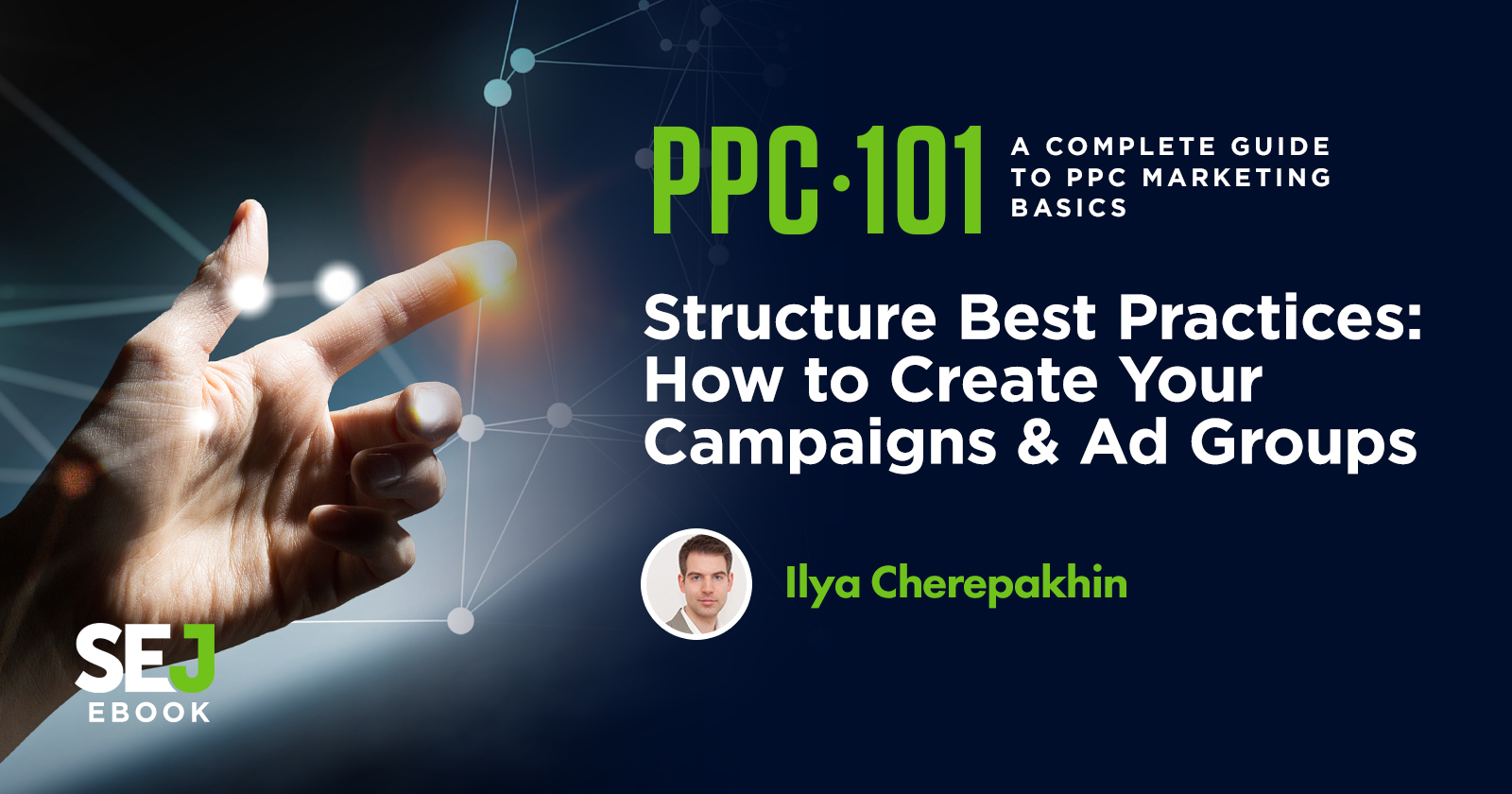Account structure is a critical element for ensuring paid search success.
Adopting structure and group best practices ensures that keywords, ad messages, and landing pages are aligned with the business’s objectives.
An effective structure is deeply connected to your marketing strategy and business needs.
One should also think beyond the initial setup and create a nimble structure that will allow for efficient ongoing maintenance and scaling campaigns with the business evolving over time.
Getting the tactical elements right ensures having a structure that is as functional as possible (e.g., supports the most effective reporting and optimization).
It will also position you well to benefit from the latest paid search innovations that increasingly rely on algorithm-based automation and scripts.
As ad groups run in the context of their campaigns, we will first review some campaign considerations.
Carefully considering how many campaigns are needed will ensure that you cover all relevant keyword themes, and each topic is housed in its own campaign.
This naturally leads to having the right number of overall ad groups and organizing them in the most relevant way.
While some structure and ad group features vary by engine, particularly across engines in non-English speaking markets, most have the same common elements.
Campaign Setup Best Practices
When deciding what and how many campaigns to have, consider which searches will need maximum coverage.
Then, evaluate what budget management, targeting, and device settings are needed to support business objectives.
Follow the Money
As budget lives at the campaign level, anything needing to have a dedicated budget deserves its own campaign.
For terms you need to fund as fully and continuously as possible, it is recommended to set up a dedicated campaign so they can be managed more easily.
It is a best practice to fully fund your own brand terms, as they target most qualified users who already know of your business.
Retargeting (i.e., RLSA) and campaigns that are of strategic importance (e.g., running in key markets) are some other use cases for needing to create priority campaigns to most closely manage key traffic pools.
Targeting Parameters
Desired engine networks, geography, and audiences will further impact your structure.
Ad group level bid modifiers can help avoid creating separate campaigns for each targeting instance.
However, for reporting, budget management, and ease of long-term keyword management, it is recommended to implement most settings at the campaign level.
This allows reporting most efficiency on performance and builds out campaigns over time, with limited steps needed each time a new group or new keywords need adding.
Networks Settings
It is often assumed that ads would show up on search results (i.e., search network only).
However, in some cases, you may want to run on syndication sites or even the display networks of the given engine.
Take a moment to check which network you need and select the right setting.
Geotargeting
For geography, it is tempting to have the same footprint as your business does with other media.
However, your search engine demand may differ from where your offline sales occur.
Take a moment to research where search engine demand is likeliest to come from (DMA, cities, states, regions, countries).
Then, set up a couple of individual campaigns for your top markets with
If budget allows, create one extra “catch-all” campaign to cover remaining traffic in the rest of the possible places where your consumers may come from.
For example, a Boston retailer may create campaigns for the Boston metropolitan area, neighboring counties, New England, and the rest of the U.S.
While it is tempting to select English or all languages, do research where the bulk of the traffic will come from and if your site fully supports that.
If you could be targeting multiple languages, do create multiple campaigns for each language version.
For example, in our earlier example, the Boston-based retailer sold flags of countries around the world, its site supported three languages, and it shipped only to the U.S. and Canada. Its structure could look something like this.
- English_Boston metropolitan area
- English_neighboring counties
- English_rest of New England
- Spanish_New England
- English_US
- Spanish_US
- English_Canada
- French_Canada
Notice that there are no Spanish or French versions to mirror English campaigns 1-3. That is due to search volume, not justifying that.
Audiences
Use first-party and any third-party data that is available to guide your structure.
Creating separate campaigns for remarketing, targeting past users with RLSA campaigns, is one common use case.
However, consider slicing your structure further, particularly if you sell multiple products or services.
For example, creating separate campaigns for users who have purchased some products but not others will allow you to closely support cross-selling business objectives with dedicated budgets, geotargeting (if needed), ads, and reporting.
This is not possible if attempted at the ad group level.
Device Settings
Performance by device continues to vary, making it an important optimization lever.
Before breaking out campaigns by device, consider these pros and cons.
- Engine algorithms have now evolved to account for device signals when optimizing bids in their automated algorithms.
- Splitting campaigns by device greatly reduces traffic and KPIs available for optimization and may create campaigns that do not have large enough volume for meaningful optimization.
- If the site has responsive design and other mobile best practices, the mobile user experience is likely quite strong, and mobile campaigns can be held to the same goals as non-mobile campaigns.
With this in mind, unless mobile devices represent a sizable amount of traffic, cost, and goals, it is not recommended to break out campaigns or groups by the device.
Instead, if you do not use automated bidding solutions, use device bid modifiers for achieve device level efficiencies and ad customizers to tailor ad message to users across different devices.
Ad Group Best Practices
Start by clustering your desired keywords by themes.
These should be as narrow as reasonably possible to avoid overlap in targeted searches.
As each group supports different ads, one way to guide ad group structure is based on the copy you expect to run in each case.
For example, if you are a retailer selling sports shoes, within your women’s shoe campaign, you could create an ad group for each brand to align with each landing page you have.
However, depending on the range of products that may prove still too general with a wide range of keywords lumped into each group.
In that case, you may want to create campaigns based on the shoe brand, with a separate group for each shoe model.
It is common for most of the traffic to be driven by a select number of terms.
In fact, occasionally, a small handful of keywords may command lots of traffic and/ or share of goals.
In those cases, you may need multiple groups so that these “power keywords” live in separate groups with other terms housed in others.
Single keyword groups are rare but use the same premise. They isolate a keyword into its own group for closest to performance, copy optimization, testing, and reporting.
With your ad group strategy in place, before you finalize and create the group structure, consider match types and how audience needs can impact ad text approach, and then evaluate landing page needs.
Match Types
For best efficiency and to simplify negative matching, it is recommended to create duplicate groups by match type.
Known as match type mirroring, this best practice entails each group having only terms of one match type.
Exact Match groups should perform the best and not need negatives barring unusual circumstances.
Phrase and Broad Match groups usually perform less well and are the focus for negative matching.
To note, to avoid group cannibalization, you will need to have your Exact Match positive terms as negatives in Phrase and Broad groups.
Match type group mirroring also has budgetary benefits.
At times of limited budget, it is much easier to pause less performing match types with them isolated in different groups.
If you have a very high-volume campaign and need superior control over costs, an alternate approach will work: mirror match types by the campaign, so each campaign only has groups and terms of one match type.
Audience Tailored Messaging
The need for different ads is a key reason for separate groups.
However, before jumping to creating more groups, see if the copy customization can be solved with a feed or an ad customizer.
Elements like price, product features, or service elements can often be fed through the business data capability.
Any time a change is needed, rather than creating new ads and groups, business data can be updated seamlessly, trickling the change to ad copy without triggering an ad Quality Score review.
When messaging needs to vary only for a single audience and that will not significantly budgeting, use ad customizers rather than creating a new group or campaign.
Customizer if statements allow for a default text to show all users and an alternate for one specified audience.
Landing Pages
Unless you are doing a lading page test to evaluate site conversion, the best practice is to use one landing page per ad group.
If multiple landing pages are needed, it is a sign that keywords are not grouped tightly, and multiple topic themes exist within the ad group.
In that case, split your group so that there is a one to one relationship between the group, landing page, and ad text approach.
It can be tempting to create a very detailed structure.
If it is starting to look complex, it probably is. Consider starting a new account.
Not everything needs to live within one engine account, and multiple ones are often needed for larger advertising efforts, particularly with multiple sources of budget involved.
Engine Parity
It is common for campaigns to be cloned from one engine to another.
However, that can create an unnecessarily large number of campaigns and groups.
As secondary engines command a much lower share of traffic, many campaigns and groups will see limited traffic.
Rather than cloning everything for each engine, replicate only on those campaigns and groups that will drive the most meaningful results, justifying the optimization and reporting efforts.
Naming convention
Any structure consideration will be incomplete without planning the campaign and group naming convention.
The best approach is succinct, reflects all targeting aspects, setting parameters, and uses special characters to separate elements.
This is key for not only administrative reasons like reporting and optimization (be it with an engine or third-party tools).
A robust naming convention facilitates scaling efforts over time.
It will simplify implementing any automated solutions, expand keywords, manage budgets, and more.
But don’t get carried away by incorporating everything imaginable into the ad group or campaign name.
The naming convention should allow determining with a naked eye what the campaign or ad group contains.
However, filters and labels should be leveraged alongside.
Use them to quickly report on various parts of your account or campaign, without using an overly complex naming convention for campaigns and groups.
Conclusion
As with any element of paid search strategy, the structure is not a static element.
Do review it periodically, especially if there are website updates.
Site content and landing page changes are opportunities to evolve your structure.
However, if you follow these best practices, future changes should be incremental and save you from overhauls that take a toll on performance.





